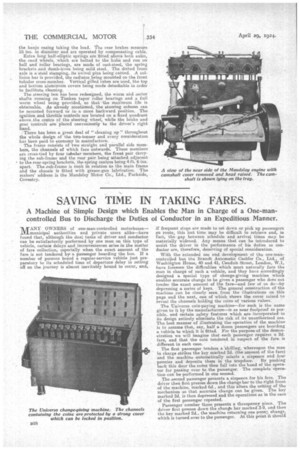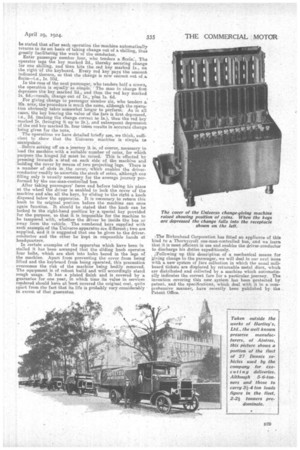SAVING TIME IN TAKING FARES.
Page 12

Page 13

If you've noticed an error in this article please click here to report it so we can fix it.
A Machine of Simple Design which Enables the Man in Charge of a One-mancontrolled Bus to Discharge the Duties of Conductor in an Expeditious Manner.
1,TANY . OWNERS of one-man-controlled motorbuses.1.V.Lmunicipal authorities and private users alike—have found that, although the dual tasks of driver and conductor can be satisfactorily performed by one man on this type of vehicle, certain delays and inconveniences arise in the matter of fare collection, especially when the exact amount of the fare is not tendered by a passenger boarding the bus. If a number of persons board a regular-service vehicle just preparatory to its scheduled time of departure delay in setting off on the journey is almost inevitably bound to occur, and,
if frequent stops are made to set down or pick up passengers en route, this last time may be difficult to retrieve and, in -fact, the gap between schedule and arrival times may be materially widened. Any means that can be introduced to assist the driver in the performance of his duties as conductor are, therefore, deserving of special consideration.
With the extended use and development of the one-mancontrolled bus the Brandt Automatic Cashier Co. Ltd., of Washington House, 40 and 41, Cenduit Street, London, W.1, have foreseen the difficulties which must naturally face the man in charge of such a vehicle, and they have accordingiy designed a special type of change-giving machine winch enables accurate change to be given a passenger who does not tender the exact amount of the fare—and few of us do—by depressing a series a keys. The general construction of the machine can be clearly seen from the illustrations on this page and the next, one of which shows the cover raised 10 reveal the channels holding the coins of various values.
The Universo coin-paying machine—for such is the name given to it by the manufacturers—is as near foolproof as possible, and certain safety features which are incorporated kr its design entirely eliminate the risk of its unauthorized use. The best manner of illustrating the operation of the machine is to assume that, say, half a dozen passengers are boarding a vehicle to which it is fitted. For the purpose of the demonstration we will imagine that each passenger requires a, 2d. fare, and that the coin tendered in respect of the fare is different in each case.
The first passenger tenders a 'shilling, whereupon the man in charge strikes the key marked 2€1. (the amount of the fare) and the machine automatically selects a sixpence and four pennies and deposits them in the trapdoor. By pushing back this door the coins then fall into the hand of the operator for passing over to the passenger. The complete operation can be performed in one second.
The second passenger presents a sixpence for his fare. The driver then first presses down the change bar to the right front of the machine, marked bd., and this alters the setting of the mechanism so that accurate change can be given. The key marked 2d. is then depressed and the operations as in the case of the first passenger repeated. Passenger number three presents a threepenny piece. The driver first presses down the change bar marked 3-9, and then the key marked 2d., the machine returning one penn:. change, which is turned over to the passenger. At this point it should
be stated that after each operation the machine automatically returns to its set basis of taking change out of a shilling, thus greatly facilitating the work a the conductor. Enter passenger number four, who tenders a .florin:, The operator taps the key marked 2c1., thereby securing change
for one shilling, and then hits the red key marked is., on the right of the keyboard. Every red key pays the amount indicated thereon, so that the change is now correct out of a florin—i.e., is. 10d.
In the case of the next passenger, who tenders half a mown, the operation is equally as simple. The man in charge first depresses the key marked 2d., and then the red key marked is. 6d.—result, change out of is;, plus is. 6d. For giving change to passenger number six, who tenders a 10a. note, the procedure is much the same, although the opera tion obviously takes somewhat lenger to perform. As in all cases, the key bearing the value of the fare is first depressed, Le., 2d. (making the change correct to is.), then the red key marked Is. (bringing it up to 2s.), and subsequent depression of the red key marked 2s. four times results in accurate change being given for the note.
• The -operations we have detailed briefly are, we think, sufficient to show that the TJniverso machine is simple to manipulate.
adore setting off on a journey it is, of coarse, necessary to load the machine with a suitable number of coins, for which purpose the hinged lid must be raised. This is effected by pressing inwards a Stud on each side of the machine and holding the cover by means of two projecting lugs. There is a number of slots m the cover, which enables the driverconductor readily to ascertain the stock of coins, although one filling only is usually necessary for the average journey performed by the one-man-controlled bus.
After taking passengers' fares and before taking his place at the wheel the driver is enabled to lock the cover of the machine and also all the keys, by sliding to the right a knob disposed below the apparatus. It is necessary to return this knob to its original position before the machine can once again function. It should be stated that the knob can be
locked in the right-hand position. by 'a special key provided for the purpose, so that it is impossible for the machine to
be tampered with, whether the driver be inside the bus or
away from the vehicle. The numbered keys supplied with each example of the TJniverso apparatus are different ; two are
supplied, and it is suggested that one be given to the driver-. conductor and the other be kept in responsible hands at headquarters. In certain examples of the apparatus which have been in
stalled it has been arranged that the sliding knob operates four bolts, which are shot into holes bored in the legs of
the machine. Apart from preventing the cover from being lifted and the keyboard from being operated, this precaution . overcomes the risk of the machine being bodily removed. The equipment is of robust build and will accordingly stand
rough usage. It has a plated finish and is covered by a guarantee for one year, in which time its value in services
rendered should have at least covered the original cost, quite sped from the fact that its life is probably very considerably in excess of that guarantee. .The Birkenhead Corporation has fitted an applianee of this kind to a Thornyeroft one-man-controlled bus, and we learn that it is most efficient in use and enables the driver-conductor to discharge his duties expeditiously.
;Following up this description of a mechanical means for giving change to the passenger, we will deal in our next issue with a new system of fare collection in which the usual millboard tickets are displaced by returnable metal discs, which are distributed and collected by a machine which automatically indicates the correct fare for a particular journey. The invention covering this new system has been protected by patent, and the specifications, which deal with it in a comprehensive manner, have recently been published by the Patent Office..






























